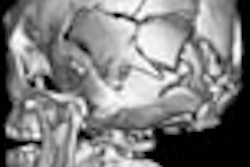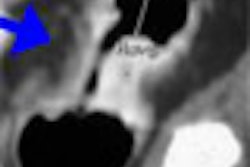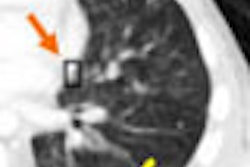LAS VEGAS - The implementation of a cardiac CT program can bolster the reputation of a practice, increase its volume and revenue, improve patient and referring physician satisfaction, and enhance interspecialty collaboration, according to Brook Ward, executive director of clinical and ambulatory services at Bronson Methodist Hospital (BMH) in Kalamazoo, MI.
"A cardiac CT program is an absolute for most medium- and large-sized facilities, and a good idea for smaller practices that can justify it," said Ward, who presented his experiences with implementing such services at the American Healthcare Radiology Administrators (AHRA) annual meeting this week.
Ward's institution is a regional, tertiary not-for-profit health system that has been providing services in the southwest Michigan area since 1900. Its more than 4,000 employees serve a population base of 1 million lives, and the facility boasts a 92% occupancy rate for its 343 licensed beds.
The radiology department is comprised of 165 full-time equivalent (FTE) employees, conducted 213,000 procedures in 2005, and is on track for 250,000 procedures this year, Ward said. The CT department performs 37,500 procedures annually with 17.5 FTEs, but had done no coronary CT angiographies (CTAs) or CT calcium scorings prior to the cardiac CT initiative.
The overarching goals of the cardiac CT program, according to Ward, were the following:
- Elevate BMH's cardiac reputation
- Develop new and increase existing referral relationships, both locally and regionally
- Attract and capture new patients into the system
- Move toward the cutting edge of cardiac care
- Increase volume
- Increase revenue, both direct and downstream
Early on in the process of developing the program, the BMH team made a strategic decision to implement CT calcium scoring exams as a break-even service that would require no physician order and that it would be marketed directly to potential patients.
A little over a year after launching the CT calcium scoring program, Ward believes that direct marketing to primary care physicians should have been implemented from the start -- a little over one-quarter of the scheduling referrals for the procedure have come from the primary care community.
A branding coup for the institution occurred when it dropped the term CT calcium scoring, which is meaningless for most of the lay public, in favor of the tag line "Bronson Heart Scan." The branding has proven so successful in the community that Ward said he has heard competing groups in the local cardiac CT market field calls requesting a Bronson Heart Scan.
However, before BMH could begin its cardiac program, it had to update its technology. According to Ward, the facility was using single- and four-slice CT systems, and these modalities were literally running at capacity 24 hours a day, seven days a week.
"Yes, we had patients scheduled for 3 a.m. CT scans," he said.
The facility obtained a 64-slice CT scanner from GE Healthcare (Chalfont St. Giles, U.K.), the 16th one off the assembly line, Ward said. If a group is going to fully embrace the development of cardiac CT in its practice, Ward believes that 64-slice capability is imperative.
Operationally, Ward shared that he created two business plans pro forma, one for the 64-slice CT system and one for the Bronson Heart Scan product, and that both items underwent separate budget-approval processes.
"Our executive team was a little unsure of how the (heart scan) retail business would work," Ward said. "So we carved it out and did it as a separate approval process, and we had separate outcomes and tracking."
The process development for the heart scan product began with creating an exam protocol, crafting scheduling criteria, conducting a patient flow analysis, launching an online heart health assessment, documenting a marketing plan, establishing a procedure for communicating results and counseling the patients, and implementing a follow-up process to ensure compliance with recommendations as a result of the scan.
The online heart health assessment tool polls viewers on several categories of family heart history and health risk questions. At the end of the survey, an eight-page heart printout of results is available and a risk assessment for heart disease is generated. Viewers are provided with information about the heart scan program and can request materials to be mailed to them.
The facility also utilized direct mail, newspapers, radio, billboards, mall boards, and newsletters to market the heart scan product, which was targeted to asymptomatic patients in the general population. In focus groups, BMH found that women were more receptive to the exam, while men indicated they would only go if their wife made them, or if they had children they needed to provide for.
Ward said they used this data to craft print ads directed at men with children, married couples, and women to launch the service. As time has progressed and scheduling referral data became available, BMH retailored its marketing to reach out to primary care physicians and internal medicine specialists, as well as the general public. A Valentine's Day promotion resulted in the sale of 65 scans, Ward said.
The Bronson Heart Scan consists of a CT exam, which is then scored for calcium. Once the exam has been scored, the patient is given private counseling on the results by a registered nurse, who explains the results and their meaning. The group developed three packages for patient take-home materials on the basis of scoring: low, moderate, and high risk.
Patients with high-risk outcomes are directed to contact their primary care physician immediately with the results. If a patient does not have a primary care physician, they are provided with one from within BMH. Follow-up phone calls and letters are sent to these patients to ensure that they see a physician with the results. If they do not, a certified letter with return receipt is sent to the patient explaining the severity of the results and the need to seek additional medical service, Ward said.
The entire Bronson Heart Scan procedure is priced at $200, which is the break-even point for the facility on the exam, according to Ward.
As of the end of May this year, the group had conducted 1,629 heart scans with about 58% falling into the low-risk category (calcium score of 1-10), 33% in the moderate- to intermediate-risk category (calcium score of 11-400), and 9% in the moderate- to high-risk category (calcium score over 400).
The downstream flow for other cardiac procedures at the facility has been about one in every 100 heart scan patients, Ward said. These comprised 57 nuclear cardiac studies, six stress echocardiography exams, 27 cath lab procedures, 15 percutaneous coronary interventions, eight coronary artery bypass grafts, and two CTA exams.
Based on his facility's experience, Ward offered the following key elements for creating a successful CT calcium scoring initiative:
- Integration with primary care providers in the planning stage
- Marketing to the appropriate patient population
- Providing a counseling session for the exam results
- Referring the exam results back to the primary care provider
- Tracking the downstream impact
- Targeting communication directly to the patients
By Jonathan S. Batchelor
AuntMinnie.com staff writer
August 3, 2006
Related Reading
More research needed to gauge CTA's benefits, August 1, 2006
Cardiac CTA a no-go zone for some, July 17, 2006
ACC studies examine CTA radiation dose, March 17, 2006
Coronary CTA requires dedication, 64-slice minimum, November 30, 2005
Cardiac MR center finds success with 'one-stop shopping' model, January 25, 2005
Copyright © 2006 AuntMinnie.com



















